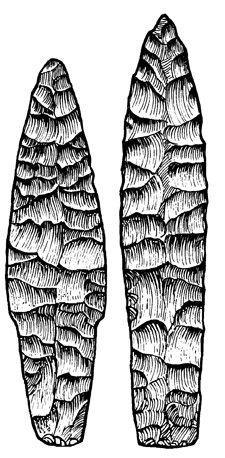MADINA PLANO POINTS
Late Paleo-Indian: 10,000 to 9,500 BP

DESCRIPTION: Madina Plano points range in size from
36 to 88 mm in length, 18 to 28 mm in width, and 3 to 11 mm in
thickness. Blade length ranges from 14 to 53 mm (averaging 28
mm) and stem ranges from 16 to 35 mm. Most points have straight
sided stems which contract from very subtle shoulders towards
a convex to straight base with rounded corners. Stem edges and
base are usually ground, and maximum blade width occurs close
to mid-point. The cross section is a flat biconvex. Surface flaking
generally consists of shallow, narrow, well-executed retouching.
This flaking can range from parallel to collateral, or simply
unpatterned in execution. However, some points still show the
remnants of broader thinning flake scars on their fore-section
surfaces representing an earlier stage in manufacture. Both blade
and stem edges have had their shape regularized by a fine intermittent
retouch.
DISTRIBUTION: These points are highly restricted in range.
They are known in southern Ontario from more northern locations,
extending from present day southern Lake Huron in the west (Ellis
and Deller 1986), around the margins of the Simcoe lowlands in
south central Ontario (Dibb 1985; Stork 1979), to Rice Lake in
the east (Jackson 1986).
RAW MATERIAL: Points are known on Onondaga, Fossil Hill,
Balsam Lake, Gull River. Kettle Point and other unidentified exotic
chert sources.
AGE AND CULTURE: The antiquity of these late Paleo-Indian
points is unknown. Their occurrence on the bed of Lake Algonquin
suggests they post-date 10,400 BP (Ellis and Deller 1986). Comparisons
of the point form to similar, well dated forms elsewhere in North
America suggests an age of roughly 10,000 to 9,500 B.P. Comparisons
have been drawn between this point form and the Hell Gap points
of western North America.
REFERENCES: London Chapter, Ontario Archaeological Society.
G. Dibb and C. Ellis, 1988 Madina Plano Points. KEWA 88-7.

